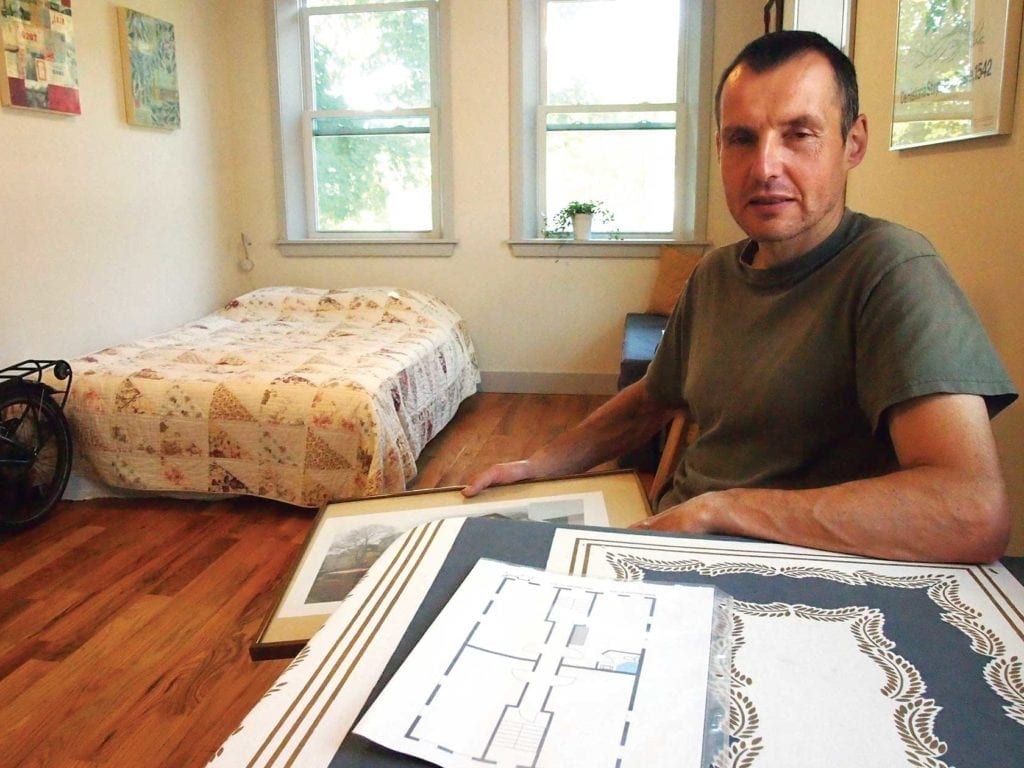
As a small business owner, Vivian Girard sees many of the workers in the home.stead bakery & cafe he and his wife own struggle to pay rents, even in the Fields Corner neighborhood where the restaurant is located.
As a licensed general contactor, Girard is taking matters into his own hands, with plans to build a 14-unit building on a lot he owns near the corner of Westville Street and Geneva Avenue, with units as small as 260 square feet and rents as low as $650 a month.
“I don’t like the concept of the over-priced small units for millennials,” says Girard, who grew up on a farm in the southwest of France and has lived in Fields Corner for the last 22 years.
While studios and micro-units in the South End and Seaport District rent for more than $2,000 a month, and the condos sell for more than $1,100 per square foot, Girard, a general contractor, says he can build his micro units for $300 per square foot, guaranteeing that the rents will stay low.

A tiny kitchen with a single stovetop, small sink and refrigerator is nestled behind dual doors. Banner Photo
Demonstration unit
To show that the scheme is feasible, Girard has constructed a demonstration unit on the site. The unit is sparsely furnished with a twin-sized bed, a large ottoman with pillows and a small table with two chairs. The unit includes a fold-out kitchen — “I wouldn’t like to feel like I’m sleeping in a kitchen,” Girard says — and a small bathroom and walk-in closet.
Under his plan, the 14 micro-units will fit into a building the size of a traditional triple-decker, with four units on each of the upper floors and two slightly larger wheelchair-accessible units occupying the basement along with bike storage, utilities and a common room. Girard, who uses a bicycle to get around, says he will not lease the apartments to people who own cars.
“It’s going to be something people will have to commit to before they sign the lease,” he said.
That last point helped sell the idea to neighborhood residents, Girard adds.
Davida Andelman, who lives nearby on Clarkson Street, admits she was skeptical at first, but after she viewed the unit, she said, her opinion shifted.
“I think it’s doable,” she said. “I think it’s worthy of community dialogue.”
Andelman, who has seen several neighbors priced out by rising rents in the Bowdoin Street neighborhood, says the affordable micro-units, if done right, could help people stay in the neighborhood.
Trend: micro size, macro price
In 2011, Boston real estate developers and city officials first began discussing the possibility of building micro-units to help meet growing demand for housing in Boston. In early 2013, the first micro-units were constructed at 63 Melcher Street in the Fort Point Channel area, with rents for a 430-square-foot set at $2,300. There, and with subsequently developed small and micro-sized apartments, density was increased, yet prices remained high. National Development last year submitted a proposal for a 245-unit building in the South End Ink Block development with sub-400-square-foot studios renting for $2,250.
In 2016, the city’s Housing
Innovation Lab built a 360-
square-foot demonstration home called the Urban Housing Unit and toured it through Boston neighborhoods to demonstrate the feasibility of micro-units and to gauge support. Girard says he visited the unit three times.
Housing Innovation Lab Director Marcy Ostberg said the majority of those who visited the demonstration unit were “hesitantly optimistic” about the concept.
“People would say, ‘This could work,’” she said.
She estimates that another 20 percent of those who viewed the unit were enthusiastic about the concept and 10 to 15 percent were adamantly against it.
“It’s okay,” she said. “It’s not a solution for everybody.”

An architect’s rendering of the 14-unit building. Image: courtesy Vivian Girard
Girard says he’s received similar reactions to his demonstration unit, depending on the age and socioeconomic outlook of the viewer.
“People who lived in a house for a long time say, ‘Yeah, it’s ok,’” he said. “Students and young people working their first jobs say, ‘When can I sign up?’”
Ostberg said she thinks the units would work best in areas that are close to public transit and if they’re built with amenities to discourage car use, such as the bicycle storage Girard plans to include and discounted T passes.
“You have to look at transportation demand management,” she said.
Moving forward
The Housing Innovation Lab plans to present a set of draft guidelines to the Boston Planning and Development Agency board in July. If approved, the guidelines would pave the way for interested developers to build micro-units throughout the city.
Mayor Martin Walsh said the guidelines are important to make sure new developments fit within the needs of the neighborhoods in which they’re sited.
“We want to be careful that some of these projects don’t turn into rooming houses, that they turn into living spaces,” he said. “We’re looking at all different styles of housing. Everything is on the table for discussion because the amount of people who want to live in the city of Boston is incredible.”
Girard plans to show his demonstration unit for several more weeks before he dismantles it. He will then have to obtain zoning variances and demonstrate sufficient abutter support before he is able to build on the site.


![Banner [Virtual] Art Gallery](https://baystatebanner.com/wp-content/uploads/2024/04/Cagen-Luse_Men-at-store-e1713991226112-150x150.jpg)



